I fell asleep and suddenly found myself 100 years ago, in Turkey at the dawn of early industrial ventures. The streets were dusty, the factories smoky, and people bustling… I, on the other hand, was in a corner baking a giant cake. I sifted the flour, cracked the eggs, and stirred with anticipation, waiting by the oven. Every detail was vivid in my mind: the gleam of the copper pots, the warmth of the oven, the sweet aroma of the cake…
At the same time, I tried to focus over the noise coming from the factory. The machines seemed to dance on their own; a wheel turned, another cylinder hopped… And then, a small smoke monster slowly emerged from the oven, gliding in front of me, lightly blocking my path. I woke up in a panic.
When I woke up, my face still smelled faintly of cake, and I thought, “How long did that dream actually last?” Popular culture says dreams last only seven seconds. But our brain plays such a trick that when we wake up, it feels like we lived through the whole night. The funny thing is, that cake-making adventure, the chaos of the factory, the dancing machines, and the smoke monster, all happened in what seemed like seconds.
The Duration of Dreams and the Brain
According to scientists, most dreams occur during REM sleep (Rapid Eye Movement). A sleep cycle lasts about 90 minutes, and the REM sleep phase gradually lengthens throughout the night. During this phase, our brain processes experiences from the day, organizes emotions, and activates imagination. So, even if the chaos of cake and factory in the dream feels like it happened in seconds, our brain is actually processing every detail over a longer period (Hobson, 2009).
Time perception in dreams is highly flexible. Complex and intense dreams can feel like they occur in a short period, while simple or static dreams may seem longer. Therefore, saying “only seven seconds” upon waking is both correct and incorrect. Our brain compresses time, layering details and emotions, and aligns all events of the dream on a single timeline (Stickgold, 2005).
The Magic of Dreaming
A dream is more than imagination. In a dream, our brain brings together the past, emotions, and creativity. That cake experience isn’t just about the oven and flour; it’s also excitement, curiosity, and a sweet accumulation of mini-adventures. While baking in the factory, workers from the era are around—some laughing, some interfering, and one wielding a giant spoon like a dancer… When we wake up, we realize that an entire night’s adventure occurred in seconds. And we smile: “Well, I finished it in seven seconds!”
Dreams provide both a magical and playful perspective. Imagine baking a cake in a factory 100 years ago, only to learn upon waking that it lasted mere seconds. The brain packs details and emotions so tightly that our sense of time perception is completely transformed. And the delightful part is that every absurd, funny, or strange detail in a dream is actually a mini-universe created by our brain.
Conclusion
Next time you bake a cake, imagine yourself in a factory or the middle of an ancient civilization. Perhaps a smoke monster emerges from the oven, or the whisk dances on its own… When you wake up, you’ll see that the entire adventure lasted only seven seconds. But those seven seconds contain an entire era, a world, and a factory’s story. Every night, there is a door to a new universe!
With love and sweet dreams,
Kaynakça
-
Domhoff, G. W. (2003). The scientific study of dreams: Neural networks, cognitive development, and content analysis. American Psychological Association.
-
Hobson, J. A. (2009). REM sleep and dreaming: Towards a theory of protoconsciousness. Nature Reviews Neuroscience, 10(11), 803–813.
-
Nir, Y., & Tononi, G. (2010). Dreaming and the brain: From phenomenology to neurophysiology. Trends in Cognitive Sciences, 14(2), 88–100.
-
Stickgold, R. (2005). Sleep-dependent memory consolidation. Nature, 437(7063), 1272–1278.
-
Revonsuo, A. (2000). The reinterpretation of dreams: An evolutionary hypothesis of the function of dreaming. Behavioral and Brain Sciences, 23(6), 877–901.
-
Memorial Sağlık Grubu. (2023). REM uykusu nedir? Uykunun evreleri nelerdir?
-
Evrim Ağacı. (2022). Rüyalar ne kadar sürer? Bize saatler gibi gelen rüyaların gerçekten birkaç saniye veya dakika sürdüğü doğru mu?
-
Ufuk Üniversitesi. (2022). Rüyalar sırasında zaman nasıl akar?


